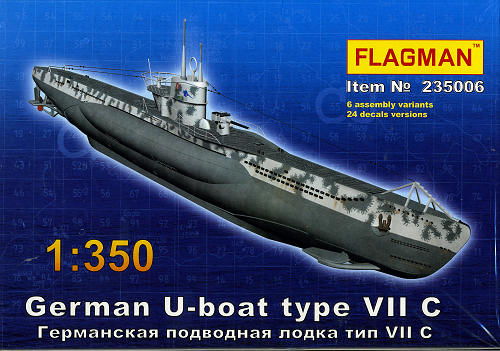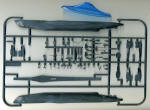
Flagman 1/350 German type VII C Uboat
| KIT: | Flagman 1/350 German type VII C Uboat |
| KIT #: | 235006 |
| PRICE: | approx $20.00 MSRP, less at www.dragonmodelsusa.com |
| DECALS: | over 20 options |
| REVIEWER: | Scott Van Aken |
| NOTES: | Full hull kit |

| HISTORY |
Type VII U-boats were the workhorses of the German World War IIU-boot-waffe. Type VII was based on earlier German submarine designs going back to the World War I Type UB III, designed through the Dutch dummy company Ingenieurskantoor voor Scheepsbouw den Haag (I.v.S) (set up by Germany after World War I in order to maintain and develop German submarine know-how and to circumvent the limitations set by the Treaty of Versailles) and built by shipyards around the world; the Finnish Vetehinen class and Spanish Type E-1. These designs led to the Type VII along with Type I, the latter being built in AG Weser shipyard in Bremen, Germany. The production of Type I was cut down only after two boats, the reasons for this are not certain and range from political decisions to faults of the type. The design of the Type I was however further used in the development of the Type VII and Type IX. Type VII submarines were the most widely used u-boats of the war and were the most produced submarine class in history, with over 700 built. The type had several modifications.
The Type VIIC was the workhorse of the German U-boat force, with 568 commissioned from 1940 to 1945. Boats of this type were built throughout the war. The first VIIC boat commissioned was the U-69 in 1940. The Type VIIC was an effective fighting machine and was seen almost everywhere U-boats operated, although their range was not as great as that of the larger Type IX. The VIIC came into service as the "Happy Time" at the beginning of World War II was almost over, and it was this boat that saw the final defeat by the Allied anti-submarine campaign in late 1943 and 1944.
Type VIIC was a slightly modified version of the successful VIIB. They had very similar engines and power, but were larger and heavier which made them slightly slower than the VIIB. Many of these boats were fitted with theSchnorchel in 1944 and 1945.
They had the same torpedo tube arrangement as their predecessors, except for U-72, U-78, U-80,U-554, and U-555, which had only two bow tubes, and for U-203,U-331, U-351,U-401, U-431, and U-651, which had no stern tube.
On the surface the boats (except for U88, U90 and U132-136 which used MAN M6V40/46s) were propelled by two supercharged Germaniawerft, 6 cylinder, 4-stroke M6V 40/46 diesels totaling between 2,800 and 3,200 bhp (2,400 kW) at a 470 to 490 rpm.
For submerged propulsion several different electric motors were used, Early models used the VIIB configuration of 2 AEG GU 460/8-276 electric motors, totaling 750shp with a max rpm: 296, while newer boats used 2 BBC (Brown Boveri & Co) GG UB 720/8, 2 GL (Garbe Lahmeyer) RP 137/c electric motors or 2 SSW (Siemens-Schuckert-Werke) GU 343/38-8 electric motors with the same power output as the AEG motors.
Perhaps the most famous VIIC boat was U-96, featured in the movie "Das Boot".
| THE KIT |
 Yet another new model company from Russia, Flagman has hit the US market with 1/350 submarines. Now I like submarines as they usually don't need photo etch rails and are generally fun and quick to build. This one comes on a single black sprue, comprising about 55 parts (you will not use them all) and has a neat little blue base on which to display it.
Yet another new model company from Russia, Flagman has hit the US market with 1/350 submarines. Now I like submarines as they usually don't need photo etch rails and are generally fun and quick to build. This one comes on a single black sprue, comprising about 55 parts (you will not use them all) and has a neat little blue base on which to display it.
Molding is really quite good for this scale and while it isn't Hasegawa, it is still more than adequate for the subject. The really neat thing is that you can build any one of three different sub-classes of type VII C boat (the box art says six, but I didn't come to the same conclusions) as you are given three different conning tower arrangements to handle several different gun platforms that jut out the back of the tower.
The hull is split vertically with a main deck insert. One then starts tacking on bits from the dive planes in front to the props and rudders in the rear. Personally, I'd paint the hull prior to adding on these other pieces as the demarcation line seems to run right through the forward dive planes. It would be easier to mask as well.
 Kit instructions are excellent with 9 construction steps, some of them broken down into subsections depending on the sub-variant boat you are building. Drawings are 3D and quite well done. Color information is given in generic, RAL, FS 595, Revell, Humbrol and Model Master references. The decal sheet is rather large for a kit like this until you realize that there are markings on it for 24 different submarines. The painting guide gives camo examples for one in each sub-variant and a listing that shows which conning tower marking goes with which boat. The sheet is nicely printed by Begemot.
Kit instructions are excellent with 9 construction steps, some of them broken down into subsections depending on the sub-variant boat you are building. Drawings are 3D and quite well done. Color information is given in generic, RAL, FS 595, Revell, Humbrol and Model Master references. The decal sheet is rather large for a kit like this until you realize that there are markings on it for 24 different submarines. The painting guide gives camo examples for one in each sub-variant and a listing that shows which conning tower marking goes with which boat. The sheet is nicely printed by Begemot.
| CONCLUSIONS |
Good to see another player in the model game. And people thought the hobby was dying! Their catalogue shows other submarines as well as a number of interesting ships, including some 1/200 Imperial Russian ships from the early 1800s. Looks like they plan on some aircraft as well. I can tell you that the LHS got several of these in and has nearly sold out already.
| REFERENCES |
July 2008
Thanks to www.dragonmodelsusa.com for the preview kit. Get yours today at your local shop or order on-line.
If you would like your product reviewed fairly and fairly quickly, please contact the editor or see other details in the Note to Contributors.